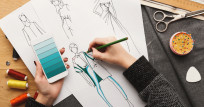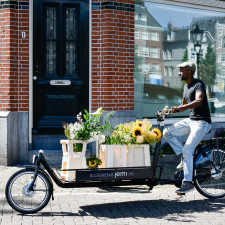Photography tips and techniques
Photographers from home and abroad share their photography tips and techniques on request at CallTheONE. Do you have a question about what camera to buy or the correct settings of your digital or analoge camera? Or do you want to know more about lighting? The professional or amateur photographers will tell you more about it.
There is a lot to discover as a photographer. New cameras and lenses create new possibilities all the time and the number of subjects you can photograph is unlimited. You can never know everything yourself. That's why you can now instantly contact photographers who have experience with the subject you have a question about.
Find the right digital photography expert, click on "Call Me Now" and immediately connect to the photographer via a Live Video Call. The first minute is free and then you pay automatically per minute as long as the call lasts. Does TheONE photographer not know exactly what you want to know? Simply call someONE who knows. Save yourself unnecessary research on Google and call directly with a professional or amateur photographer.

How do you become a better photographer?
In the article the 10.000 miles it is described that if you want to become really good at something, you have to practice a lot.
While experimenting you will learn from your mistakes and you will discover the subjects that really interest you to photograph. Only practice makes you a better photographer, but it never hurts to get some tips from professionals. In this way, you avoid the most common photography mistakes by beginners.
Most professional photographers only have a few subjects as a specialization. This is because each subject requires a different approach and technique. Portrait photography requires interaction with the person, while landscape photography requires knowledge of natural light. If you try to photograph a lot of subjects, you will find out where your passion and talent lie.
Online photography courses
There are several photography courses, but they are usually very expensive. There is also a cheaper alternative, the online photography course. Of course, you can also watch several YouTube videos or do some self-study with a few books, but that is often very difficult. In addition, good online videos and books often also cost quite a lot of money.
If you want to study online photography or take a course, you have two options. Classroom study or private lessons from an online photography teacher. If you choose the latter option, you can always learn more by watching free YouTube videos. If there is something you don't fully understand, you can discuss it with your own private teacher.
Especially if you are just starting to photograph, an online private photography teacher can be the fastest and cheapest way to learn. That's because the photographers at TheONE like to teach you even though they are not a full-time teacher. They charge a much lower price because it is their hobby, but they often know at least as much.
Can anyone learn to photograph?
Yes, everyone can learn to photograph, but it takes patience and perseverance to create exceptional photos. It starts with getting to know the basics of photography. It is also very important to know your camera and its settings. Then you will learn about the different lighting techniques and compositions.
Remember that it is not so difficult to learn how to ride a bicycle, but to become a professional cyclist takes more effort. This is also the case with photography. The more time you put into it, the better your photos will become.
Learning to photograph - the basics
The basis of photography consists of a few basic principles. Below are 5 tips that give immediate results.

The Rule of Thirds
The basic rule in photography is The Rule of Thirds. This means that the subject you are photographing is always a third from above or below or from left or right in the picture. If you draw two horizontal lines and two vertical lines, your subject should touch exactly the intersection of one of the lines.
The psychology behind this is that our brains are derived from chaos. We want to categorize information. The Rule of Thirds makes 9 equal boxes that contain any other information. Almost all people experience this as calm and clear. That is why it is pleasant to the eye.
It is possible to apply the "a fourth" or "a fifth line" rule. This can create an exciting image but requires more peace and quiet around the subject. If the rest of the image is too hectic, many people may still experience this as a restless image.

Create depth through people or objects
When you take a picture, you know what the environment was like, but that works differently with photos. As people, we think in 3d. In order to be able to see and experience depth on a 2D photo, we need a comparison. For example by placing a person in the picture and showing a lot of surroundings. This way we get an impression of how big or small the environment is.
If you want to photograph an object such as a table or a painting, the environment can also help us to estimate its size. But if you want to photograph a smaller object like a plate or a spoon, the environment can give a distorted image. Then place a napkin or another familiar object to convey depth and size.

Decoration and colour
Everybody loves colours. Lighting can light up colours and make them more beautiful, but make sure you have a calm colour composition. As a child, most of us mixed up all the different colours. This resulted in a brown or grey smudge. Make sure your image stays calm by choosing your point of view and composition in such a way that there is a nice composition of colours.

Photos are about dark and light tones
The eye needs shade and light to understand what we see. Play a lot with shadow and extra light to make a picture more interesting. Place your object or person in the right light and it can suddenly look very exciting on the photo. Sometimes you want to leave something to the imagination and exposure and light can help you with that.
Over-exposure can be a very nice effect, but the same goes for something or someone completely underexposed. You see just too much or too little which stimulates the fantasy.

Which background do you choose for portrait photography?
In any case in portrait photography, but also with other shots, the art of each photo is to keep your image peaceful. You want to focus on the subject and not on everything that can derive from it. So be sure to choose a calm background for portrait photography or give the subject much more focus than the rest.
How much does it cost to become a professional photographer?
You decide what you want to spend to become a professional photographer. You can start with any camera. Even with your Smartphone, you can take beautiful photos. It also differs per subject you want to specialize in. For portrait photography, it is useful if you have a good set of lamps and for landscape photography or sports photography, different lenses are a plus.
The basic set of a photographer consists of the following equipment:
- The camera with an extra set of batteries and a good flash.
- Multiple lenses
- A tripod
- A lamp set consisting of at least 2 softboxes and a light meter.
- 2 reflection screens
The rest of the available equipment is handy but doesn't necessarily make for better photos.
Why aks advice at TheONE?
3 Reasons to call a photographer via a Live Video connection on CallTheONE.:
- Direct answer to your questions about photography or digital cameras, settings, and lenses
- The photographer can look along through your camera and see what you do or should do to achieve the desired effect
- Only paying for an answer is cheaper than a whole course
You are standing in the middle of the field to photograph those running horses at sunset, but you can’t shoot them the way you want. In this case, download TheONE expert app and let a photographer look along and advice from a distance!

A million digital photography tips of professionals for beginners
You do not have to reinvent the wheel. Professional and amateur photographers from all over the world have already experienced what you encounter. Contact them to get started immediately.
Questions you can ask include:
- What are the best conditions for a model shoot?
- Which camera is the most suitable for me?
- What are the best lenses for a novice photographer?
- How do all settings work on my new camera?
- How to take photos that are sharp?
- How to improve my wildlife photography skills?
- What is the best shutter speed?
- How can I enhance my photos with Depth of Field (DoF)
- How do I become a good model, portrait, landscape or street art photographer?
- How much can I earn from a photo as a novice photographer?
- What is the best photo editing software like Photoshop and Lightroom
- What are the best photography styles?
- How do I become a professional Smartphone photographer?
- How can I best use photo's to use for my drawings or movie?
You know better than anyone what questions you want the answer to. That's why the photographers are online and immediately available on CallTheONE to give you the answer you are looking for.
Photography tips from advanced professionals
Even though you have years of experience, you can always learn more when it comes to photography and the amount of light. Your camera settings no longer have any secrets for you.
But for example, you would like to become a better food photographer. Of course, you will master this quickly and easy by yourself, but with a few tips from other professionals, it will be even easier to broaden your knowledge and skills.
Image editing for photographers
With the right Photoshop and Lightroom skills, you do not even have to be a top photographer to make beautiful pictures. Even though the difference between a professional photographer and an amateur is to create a great photo instead of a beautiful image, photo editing skills are always useful.
Most professional photographers know everything about photo editing and will be happy to share this knowledge with you. Thanks to the screen sharing functionality at TheONE you can look along with your image manipulation teacher and learn the tricks of the trade. Stop watching tutorials and ask the expert via Video Calling to save a lot of time.
-
Natalie RamosPhotographer/WriterUS$ 0,08 pm
-
Glenn van den BoschPhotographer writerUS$ 0,29 pm
-
Michael KlinkhamerPhotography-CoachFree
-
Elena Chilphotography, fashion, skate, travelUS$ 0,98 pm
-
Erica ModlinphotographerUS$ 0,08 pm
-
Dylan DuganCreating photographsUS$ 0,25 pm





























